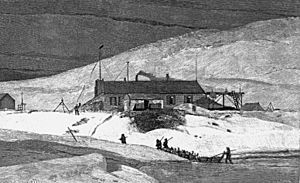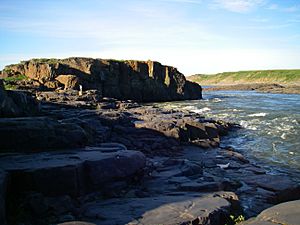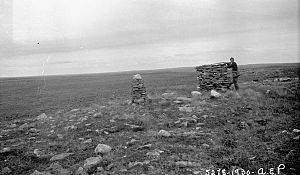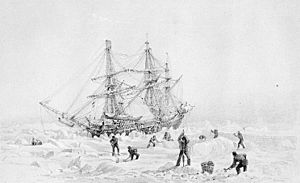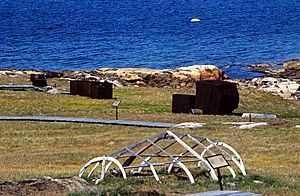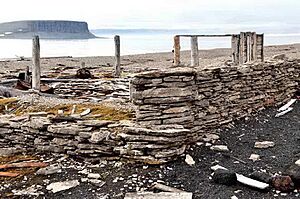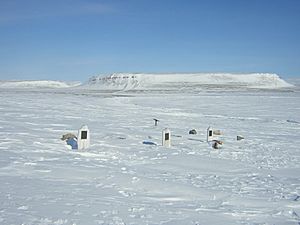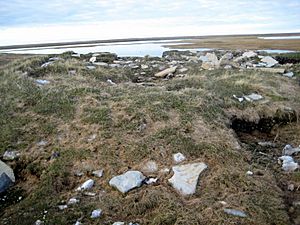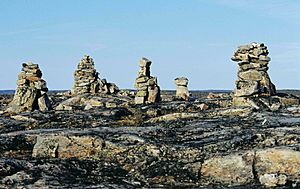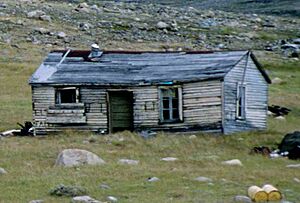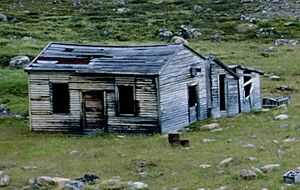List of historic places in Nunavut facts for kids
Canada's northern territory of Nunavut is a huge land filled with amazing history! This article will take you on a journey to discover some of the most important historic places in Nunavut. These are special spots that tell stories about the past, from ancient Inuit cultures to brave explorers and important events. Some of these places are recognized by the Canadian government, while others are important to the local communities. Let's explore the cool history hidden in Nunavut!
Contents
- What are Historic Places?
- Exploring Nunavut's Historic Treasures
- Fort Conger
- Arvia'juaq and Qikiqtaarjuk National Historic Site
- Bloody Falls National Historic Site of Canada
- Fall Caribou Crossing National Historic Site
- Wrecks of HMS Erebus and HMS Terror National Historic Site
- Kekerten Island Whaling Station National Historic Site
- Blacklead Island Whaling Station National Historic Site
- Beechey Island
- Wreck of the HMS Breadalbane National Historic Site
- Igloolik Island Archaeological Sites National Historic Site of Canada
- Inuksuk National Historic Site of Canada
- Former HBC Ford Lake Post Buildings
- See also
- Images for kids
What are Historic Places?
Historic places are locations, buildings, or areas that have special meaning because of their history. They can be places where important events happened, where people lived long ago, or where unique buildings stand. Protecting these sites helps us remember and learn from the past. It's like a giant outdoor museum that tells the story of Canada!
Nunavut is home to many incredible historic sites. Each one offers a glimpse into the lives of the people who lived there and the challenges they faced. From ancient hunting grounds to famous shipwrecks, these places are full of stories.
Fort Conger
Fort Conger is located far north on Lady Franklin Bay near Alert. It was built in 1881 by an American Arctic expedition led by Adolphus Greely. This expedition aimed to set up a scientific station in the Arctic. The fort was used again by explorer Robert Peary in the early 1900s as he tried to reach the North Pole. It's a reminder of the tough challenges early explorers faced in the Arctic.
Arvia'juaq and Qikiqtaarjuk National Historic Site
This historic site is found near Arviat on Sentry Island. It's a very important place for the Inuit people. For thousands of years, it was a traditional gathering and hunting area. People would come here to hunt caribou and other animals. It shows how the Inuit lived off the land and sea for generations.
Bloody Falls National Historic Site of Canada
Bloody Falls is on the Coppermine River near Kugluktuk. This site is known for a tragic event in 1771. A group of Dene warriors, guided by explorer Samuel Hearne, attacked a camp of Inuit people here. It's a sad reminder of past conflicts between different Indigenous groups. Today, it's a place for reflection and learning about the history of the region.
Fall Caribou Crossing National Historic Site
Located on the Kazan River near Baker Lake, this site is crucial for understanding Inuit and Dene history. It's a place where caribou have crossed the river for thousands of years during their migrations. Indigenous people would gather here to hunt caribou, which were vital for their survival. The site includes ancient campsites and Inukshuk (stone markers) that guided hunters.
Wrecks of HMS Erebus and HMS Terror National Historic Site
These are the famous shipwrecks of HMS Erebus and HMS Terror, found in Erebus Bay near King William Island. These ships were part of Sir John Franklin's ill-fated expedition to find the Northwest Passage in 1845. Both ships became trapped in ice and were lost, along with all their crew. Their discovery in recent years has been a huge archaeological breakthrough, helping us understand what happened to the expedition.
Kekerten Island Whaling Station National Historic Site
Kekerten Island near Pangnirtung was once a busy whaling station. In the 1800s, European and American whalers came to the Arctic to hunt whales for their oil and baleen. This station was a base for their operations. You can still see the remains of buildings and equipment from that time. It tells the story of a time when whaling was a major industry in the Arctic.
Blacklead Island Whaling Station National Historic Site
Like Kekerten, Blacklead Island near Pangnirtung was another important whaling station. It also became home to one of the first Anglican missions in the Canadian Arctic. The mission provided education and healthcare to the Inuit. The site shows how European influence grew in the Arctic, bringing both trade and new ways of life.
Beechey Island
Beechey Island is in the Wellington Channel near Resolute. This small island is famous as the first wintering site for Sir John Franklin's lost expedition in 1845-46. Three of his crew members died here and were buried on the island. Their graves are a somber reminder of the dangers of Arctic exploration.
Wreck of the HMS Breadalbane National Historic Site
The HMS Breadalbane was a supply ship that sank in 1853 while searching for the Franklin expedition. It lies in the waters near Beechey Island. This shipwreck is one of the best-preserved wooden ships in the world, thanks to the cold Arctic waters. It offers a unique look at a 19th-century sailing ship.
Igloolik Island Archaeological Sites National Historic Site of Canada
Igloolik Island is a very important archaeological site near Igloolik. It has evidence of human occupation dating back thousands of years. Archaeologists have found tools, bones, and remains of ancient dwellings from different Inuit cultures. It's like a giant puzzle that helps us understand how people adapted to life in the Arctic over time.
Inuksuk National Historic Site of Canada
Located on the Foxe Peninsula of Baffin Island, this site is famous for its many Inukshuk. An Inukshuk is a stone landmark built by the Inuit for navigation, as a hunting aid, or to mark sacred places. This site has hundreds of these unique stone figures, making it a powerful symbol of Inuit culture and ingenuity.
Former HBC Ford Lake Post Buildings
In Ukkusiksalik National Park, you can find the remains of the former Hudson's Bay Company (HBC) Ford Lake Post. The HBC was a very important trading company in Canadian history. At this post, there are old buildings like a dwelling, a store/warehouse, and a tractor depot. These structures tell the story of the fur trade era and how goods were exchanged between traders and local Indigenous communities.
Dwelling/House
This building was likely where the manager or staff of the trading post lived. It shows the kind of living conditions people had in remote Arctic trading posts.
Store/Warehouse
This building was used to store goods for trade, like furs from the Inuit and supplies brought in by the company. It was the heart of the trading operations.
Tractor Depot
This building housed tractors and other equipment used to transport goods and supplies across the land. It shows how technology changed the way people lived and worked in the Arctic.
See also
Images for kids


